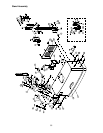
28
1. Release the fence locking handle (A, Figure
46) and remove the two hex nuts and
washer (B, Figure 46) holding the fence to
the slide bracket. Remove the fence
assembly.
2. Remove the key (C, Figure 46) from the
fence support. If necessary, use a flat head
screwdriver to pry up one end of the key.
3. Replace the fence assembly at the desired
angle across the cutterhead. See Figure 47.
Secure the fence to the slide bracket with
the hex nuts and washer (B, Figure 46),
then tighten the fence locking handle (A,
Figure 46).
NOTE: When placing the fence assembly back
into normal position, be sure to first install the
key (C, Figure 46) into its slot.
Maintenance
Disconnect machine from
power source before doing any
maintenance. Failure to comply may cause
serious injury.
The table and fence surfaces must be kept
clean and free of rust for best results. Some
users apply a thin coat of paste wax. Avoid
waxes or protective sprays that contain silicone,
as this can transfer to the workpiece and make it
difficult for later finishes to adhere to the wood.
Another option is talcum powder applied with a
blackboard eraser rubbed in vigorously once a
week; this will fill casting pores and form a
moisture barrier. This method provides a table
top that is slick and allows rust rings to be easily
wiped from the surface. Important also is the
fact that talcum powder will not stain wood or
mar finishes as some other products.
Gum and pitch which collect on the knives
cause excessive friction as the work continues,
resulting in overheating of the knives, less
efficient cutting, and consequent reduction in the
life of the knives. Use oven cleaner or “gum and
pitch remover” to wipe this off the knives. Use
caution when working around knives!
The bearings in the cutterhead are sealed for life
and do not require lubrication.
The fence assembly should slide easily over the
slide bracket. Keep the slide bracket, shown in
Figure 48, lubricated with a good quality multi-
purpose grease. Do not get grease on the drive
belt.
Do not place heavy objects on the tables, or use
the jointer as a storage table.
Figure 46
Figure 47
(skewing the fence)
Figure 48


















